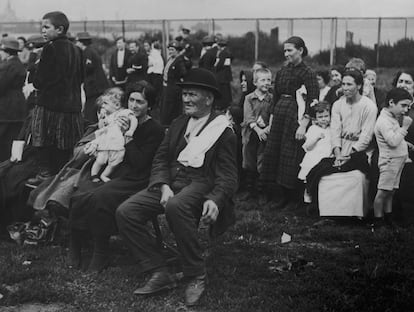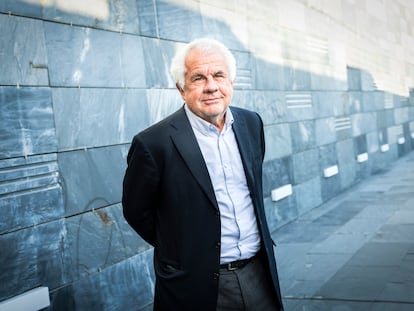From Spain’s post-war exodus to Ireland’s coffin ships: Migration is key to understanding European culture
The obsession with framing migration as an invasion is especially jarring in Spain, a country that hundreds of thousands of people left to escape misery and Franco’s dictatorship

In Europe, we are all migrants, children of migrants or relatives of migrants. We all know someone who has had to move to make a living. Now, the rising far-right, with the support of opportunistic politicians such as France’s Emmanuel Macron and Britain’s Rishi Sunak — both willing to sell their souls to the devil as if they were unaware that Faustian pacts destroy the signatory — is pointing to migration as the source of all the continent’s problems as if we were suffering some kind of invasion. Without immigrants, the European economy would be in the doldrums, as would that of the U.S. Currently we are watching desperate people fleeing poverty, war and climate change — problems for which the West is undoubtedly responsible — as millions of Europeans have done before them.
The ships leaving Ireland for America in the 19th century were called coffin ships because of the horrible conditions in which the voyage was made. These coffin ships were the small, migrant-filled boats of that era. In The Famine Plot, a book about the potato famine, the historian Tim Pat Coogan describes how, between 1847 and 1848, when people were starving in Ireland’s cities and towns, migration accelerated, not unlike what we are now seeing in the Mediterranean and the Atlantic. Hundreds of thousands of Irish people took to the sea: it is estimated that out of a population of 8.5 million, one million died of starvation at home and one million emigrated.
Coogan focuses on what happened on specific ships, such as the Lord Ashburton, which arrived in Quebec on October 30, 1847. “This overcrowding would in itself have made the passage a hellish experience,” Coogan writes, “but in addition to the overcrowding, fever had broken out, and 107 passengers had been buried at sea. Nearly half the survivors were described as being almost naked, to an extent that eighty-seven of them had to be clothed before they could be allowed ashore.” It is an image that we see almost every day today. Only the landscape has changed: it is no longer the ports on the East Coast of North America; it is Lampedusa, El Hierro and Lesbos.
Irish culture is deeply impregnated with the memory of that traumatic period. The Pogues’ song Thousands Are Sailing features the ghost of one of those migrants who died on a coffin ship. “Thousands are sailing / across the Western Ocean / To a land of opportunity / That some of them will never see.” One of the most emotionally charged events in the music industry in 2023 was the funeral of Shane MacGowan, The Pogues frontman, who died in November. After communion, singer-songwriters Glen Hansard and Lisa O’Neill performed a version of Fairy Tale of New York while those who had come to pay their last respects got up to dance. Again, it is a song about immigrants in New York who have had their dreams shattered.
Like the Irish, the Scandinavians also transformed their own culture — and that of the U.S. — when they began to cross the Atlantic en masse in the 19th century, like the Italians, and the Galicians who headed south to Argentina. Life was tremendously difficult in their own countries at the time: the desperation for something resembling a future led migrants to end up in the hands of ruthless human traffickers. A beautiful, disturbing short story by Leonardo Sciascia entitled The Long Journey from his volume of short stories The Wine-Colored Sea, describes how a group of Sicilians leave by boat for a place called “Bruquilin” in “Nuevaoir” to finally land just up the road from where they began after a journey that simply took them around their own island, but which was hellish and terrifying.

In 1972, Swedish director Jan Troell’s film The Emigrants was nominated for an Oscar and won a Golden Globe. Starring Max von Sydow and Liv Ullmann, it tells a universal story that back then could have taken place in any of the thousands of villages in Europe — and now in many places around the world, from Africa to Latin America: people fleeing conditions of servitude and eternal poverty in search of a new life, who have to face a possibly lethal journey into the unknown.
Filmin offers a version of the same story in a three-episode series, also titled The Emigrants. “Are we going to condemn our children to a life of misery for fear of the unknown?” the father asks his wife, determined to leave despite the dangers of crossing the Atlantic. “Ships sink. The sea is the tomb of the infidels,” a neighbor tells them when she learns of their plans. Now the Nordic countries are some of the richest and most prosperous places in the world: it is hard to imagine that, for centuries, they were lands of hunger, despair and servitude.
This obsession with framing migration as an invasion is especially jarring in Spain, because migration is far from being a distant collective memory. It was our parents, our uncles and aunts — and also us during the economic crisis of 2008 — who headed north in search of a future. Those who left faced prejudice, but also got ahead and profoundly changed the places they went to, though in many cases, they never stopped missing the country they had fled as political or economic refugees.
It is worth re-watching ¡Vente a Alemania, Pepe!, which Pedro Lazaga directed in 1971. The movie starts in Peralejos, a village in Teruel, where the priest still turns off the TV if he considers the program too risqué. Emigrant José Sacristán returns to this village with his Mercedes-Benz and all his dreams apparently fulfilled. And he convinces his childhood friend, Alfredo Landa, to go back with him to Munich. Clichés, berets and sideburns aside, it is still a portrait of the yearnings of a society stuck in a backwater controlled by a dictatorship. “When you earn one peseta here you earn four duros there?” Landa asks Sacristán. “There is nothing but Fanta and sunflower seeds here,” another character says about a Spain mired in Franco’s dingy post-war era.

Subject to reality, the dream of living in Germany becomes life as third-rate citizens with second-rate jobs. The pair live in a pension with Antonio Ferrandis, a Republican exile, who still goes on about the Republican defeat in the Battle of Brunete — “If we had won, you would not be here,” he points out. When his fellow Spaniards return home for Christmas, Ferrandis says: “I can’t go back. Everyone has died. Even my enemies. I would enter the casino and no one would know me. I’d be as foreign as I am here.”
It is a feeling that many migrants share: they no longer belong anywhere. Leaving a country to become a foreigner is almost always a hard experience, even when things are going well. To attack migration and make it Europe’s central problem is to deny who we are and one of the most significant aspects of our history.
Sign up for our weekly newsletter to get more English-language news coverage from EL PAÍS USA Edition
Tu suscripción se está usando en otro dispositivo
¿Quieres añadir otro usuario a tu suscripción?
Si continúas leyendo en este dispositivo, no se podrá leer en el otro.
FlechaTu suscripción se está usando en otro dispositivo y solo puedes acceder a EL PAÍS desde un dispositivo a la vez.
Si quieres compartir tu cuenta, cambia tu suscripción a la modalidad Premium, así podrás añadir otro usuario. Cada uno accederá con su propia cuenta de email, lo que os permitirá personalizar vuestra experiencia en EL PAÍS.
¿Tienes una suscripción de empresa? Accede aquí para contratar más cuentas.
En el caso de no saber quién está usando tu cuenta, te recomendamos cambiar tu contraseña aquí.
Si decides continuar compartiendo tu cuenta, este mensaje se mostrará en tu dispositivo y en el de la otra persona que está usando tu cuenta de forma indefinida, afectando a tu experiencia de lectura. Puedes consultar aquí los términos y condiciones de la suscripción digital.
More information
Archived In
Últimas noticias
Rowan Atkinson tops Netflix at 70: ‘He’s as funny as ever’
Israeli recognition of Somaliland stirs up the Gulf
Tiger Woods turns 50: Will he continue playing on the PGA Tour or take a back seat?
The surreal journey of James Nnaji, the Barcelona youth player selected in the NBA Draft who ended up in the NCAA
Most viewed
- Oona Chaplin: ‘I told James Cameron that I was living in a treehouse and starting a permaculture project with a friend’
- Reinhard Genzel, Nobel laureate in physics: ‘One-minute videos will never give you the truth’
- Sinaloa Cartel war is taking its toll on Los Chapitos
- Why the price of coffee has skyrocketed: from Brazilian plantations to specialty coffee houses
- Chevy Chase, the beloved comedian who was a monster off camera: ‘Not everyone hated him, just the people who’ve worked with him’











































